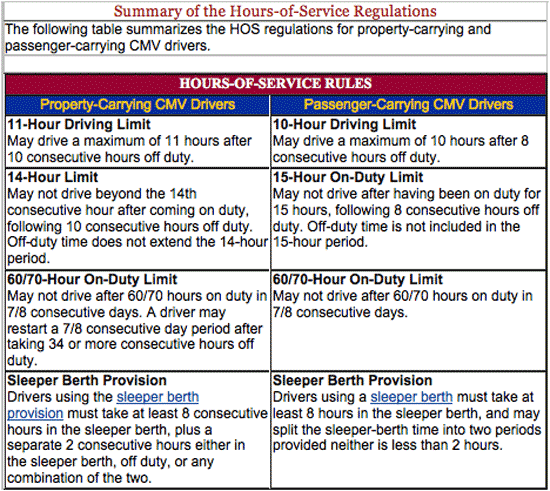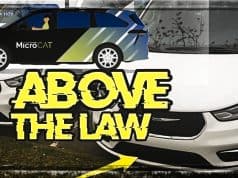Asleep at the wheel—How the Federal Government’s failure to resist lobbyists has made the highways dangerous for us all
by Clifton Smith
 The recent tour bus accident on Interstate 95 near Kings Dominion has contributed to a particularly bloody period on our nations roadways. In that incident, driver fatigue was cited as the reason for the driver running off of the road, overturning his bus upside down, onto the roof, killing four, and injuring more than two dozen others. Earlier this year, three other tour buses were involved in accidents, which had little to do with unsafe equipment, but everything to do with the one portion of the equation that can not be abused for long, without dire consequences. That portion being the human factor, the bus operator.
The recent tour bus accident on Interstate 95 near Kings Dominion has contributed to a particularly bloody period on our nations roadways. In that incident, driver fatigue was cited as the reason for the driver running off of the road, overturning his bus upside down, onto the roof, killing four, and injuring more than two dozen others. Earlier this year, three other tour buses were involved in accidents, which had little to do with unsafe equipment, but everything to do with the one portion of the equation that can not be abused for long, without dire consequences. That portion being the human factor, the bus operator.
As per their government operational norm, senators and congressmen are calling for investigations, strict enforcement of regulations, and possibly new regulations to pile on to those already in existence—all to assure passenger safety. While this is an honorable goal, and like most intents of government, quite lofty in its ambitions, I submit that it is the failure of the federal government in the first place, that has allowed such tragedy to transpire upon our highways. I submit, that had the legislators of years past stood for a commonsense approach rather than bowing to the interests of lobbyists in the transportation industry, these deaths would not have occurred.
First and foremost, there is absolutely no need for any further rules or regulations to be crafted regarding the motor coach industry. The Federal Department of Transportation already has in existence, a book of regulations that cover just about every single issue that could arise and provides explicit contingencies and redundantly excessive languag, in order to control almost every aspect of all commercial vehicle operations. While there are many points that I could take issue with, I would like to keep my comments focused on the concept of driver fatigue. Ultimately, most all other issues can be adequately handled by an alert, fully cognitive operator.
All commercial vehicle operators are closely scrutinized and carefully screened prior to obtaining their Commercial Driver License (CDL). The matter of driver fatigue is extensively and intricately regulated, per Federal DOT guidelines. In order to make the rest of this treatise understandable, here is a brief excerpt from the Federal DOT guide book.
Passenger-Carrying Vehicles
Logging Example #22 (Passenger-Carrying Vehicles)
Violations: There are no violations.
Explanation — 10-Hour Limit: After 8 consecutive hours off duty, the driver was eligible to drive for up to 10 hours beginning at 2:00 a.m., which the driver did. He or she then took another 8 consecutive hours off duty, giving the driver another 10 hours of driving time available.
NOTE: The 8-hour break can be any combination of off-duty and sleeper-berth time, as long as the time is all consecutive and not broken by any on-duty activity.
Explanation — 15-Hour Limit: After 8 consecutive hours off duty, the driver had 15 on-duty hours available at 2:00 a.m. By noon, the driver had used 10 of those hours. The driver then took another 8-hour break, giving him or her another full 15 hours available.
NOTE: The 8-hour break can be any combination of off-duty and sleeper-berth time, as long as the time is all consecutive and not broken by any on-duty activity.
Logging Example #23 (Passenger-Carrying Vehicles)

 Violations: There are no violations.
Violations: There are no violations.
Explanation — 10-Hour Limit: After 8 consecutive hours off duty, the driver was eligible to drive for up to 10 hours beginning at 8:00 a.m. on Day 1. The driver reached the 10-hour driving limit at 6:00 a.m. on Day 2, when he or she stopped driving. The driver then took another 8 consecutive hours off duty, giving him or her another 10 hours of driving time available.
NOTE: Off-duty periods of less than 8 consecutive hours do not result in additional driving time.
Explanation — 15-Hour Limit: After 8 consecutive hours off duty, the driver, at 8:00 a.m. on Day 1, had 15 on-duty hours available during which to drive a CMV. By including only on-duty and driving time in this calculation, the driver reached the 15-hour limit (2 + 4 + 2 + 2 + 1 + 3 + 1 = 15) at 6:00 a.m. on Day 2, when he or she had to stop driving. At that point, the driver continued working for 2 hours, which is allowed as long as there is no more CMV driving. In order to return to driving, the driver needed at least 8 consecutive hours off duty, which was obtained by 4:00 p.m. on Day 2, at which point the driver again had 15 on-duty hours available (10 of which could be driving).
NOTE: Off-duty and sleeper-berth periods, no matter how short, are not included in the 15-hour calculation. In addition, a driver can continue to work beyond the 15-hour limit, as long as there is no more CMV driving.
Logging Example #24 (Passenger-Carrying Vehicles)
 Violations: There is a 15-hour rule violation from 10:00 p.m. – midnight.
Violations: There is a 15-hour rule violation from 10:00 p.m. – midnight.
Explanation — 10-Hour Limit: After 8 consecutive hours off duty, the driver was eligible to drive for up to 10 hours beginning at 2:00 a.m. The driver reached the 10-hour driving limit at midnight, so there are no 10-hour rule violations on this log.
Explanation — 15-Hour Limit: After 8 consecutive hours off duty, the driver, at 2:00 a.m., had 15 on-duty hours available during which to drive a CMV. The driver accumulated 15 on-duty hours (including on-duty and driving time) by 9:00 p.m. The 15-hour rule was violated when the driver drove a CMV at 10:00 p.m. without first having another 8 consecutive hours off duty.
NOTE: Off-duty and sleeper-berth periods, no matter how short, are not included in the 15-hour calculation.
Logging Example #25 (Passenger-Carrying Vehicles)
 Violations: There is a 10-hour rule violation from 8:00 p.m. – 9:00 p.m.
Violations: There is a 10-hour rule violation from 8:00 p.m. – 9:00 p.m.
Explanation — 10-Hour Limit: After 8 consecutive hours off duty, the driver was eligible to drive for up to 10 hours beginning at 4:00 a.m. The driver reached the 10-hour driving limit at 8:00 p.m. and violated the rule by continuing to drive for another hour.
NOTE: The 2-hour off-duty period does not provide the driver with additional driving time.
Explanation — 15-Hour Limit: After 8 consecutive hours off duty, the driver, at 4:00 a.m., had 15 on-duty hours available during which to drive a CMV. The driver accumulated just 14 on-duty hours (including on-duty and driving time) by 9:00 p.m., so there were no violations.
NOTE: Off-duty and sleeper-berth periods, no matter how short, are not included in the 15-hour calculation.
All of that having been said, the long and short of it is this, a driver can only drive a maximum of 10 hours per day, and he can not be “On Duty” more than a total of 15 hours per day. Now let us examine how that really works.
The examples, like all things associated with government, are done with the “in a perfect world” notion of thinking. In the real world, applied by real people, trying to run a real business and attempting to generate real revenue, these regulations take on a whole different meaning. And it is here, or rather in the past, when these laws were passed, that those representatives of “WE THE PEOPLE” failed. Had proper concern for public safety been a real priority, and not the priority of generating cash flow for re-election, etc, the guidelines that have been established, would have been far more protective of the passenger. Let me explain. You will note that on all of the aforementioned log examples, there is the first category of “Off-Duty”. While this may seem comfortably safe and secure, the general public must understand that their off the cuff definition of “ Off Duty” is far and removed from the manner in which it is applied in the motor coach industry., “Off Duty” does not mean rest. It simply means that the operator is not engaged in the duties of driving, as defined by the DOT. To better understand my meaning, allow me to give you a real world example of exactly how dangerously thin the line is, between legal and common sense.
Example:
Tom lives an hour and a half from the bus yard. He must arrive there within a timeframe which allows him sufficient time to pre-trip his bus for safety, per federal DOT guidelines. Generally, this will take twenty minutes. If his scheduled time to depart the yard (the time his driving line commences), is say, 06:00 AM, he must arrive there by 05:40 AM at the latest. He will depart his home at 04:00AM. This means he probably awoke at 02:00 – 02:30 AM. So his feet hit the floor, and he is awake at that time.
His passenger pick-up time is at 07:30AM. So he has driven for 1.5 hours, leaving him now with 9.5 hours of driving time. His duty status changes when he arrives at his pick-up point, to “Off Duty” as he waits for his passengers. Forty-five minutes later, everyone is on board, and off they go. At 08:15, Tom’s status changes to “Driving”. He drives to the amusement park 3.5 hours away.
At 11:45, Tom arrives at the park, and his passengers disembark. His duty status changes to “Off Duty”. The passengers stay at the park until 09:00PM. Tom has had no where to go or nothing to do. Because of regulations legislated by the state of Virginia, state code 46.2-1224.1he can not idle his bus for more than 15 minutes. In other words, during record breaking heat, Tom is cooking in his bus. He has probably opened the windows and the roof hatch, and with a little breeze, the interior of the bus is only 105 degrees. He may have brought a chair and a book, to sit out under the shade of a tree and read for awhile. Whatever, he is hot and more importantly, he is fatigued. He has been “Off Duty” yes, but what were the conditions of his time “Off Duty”? Were they conducive to safety? You be the judge.
Now at 09:30PM after multiple head counts, the passengers are ready to leave. Tom’s duty status goes from “Off Duty” to “Driving”. Yes, he has had 9 hours and 45 minutes off, but again, careful examination of those conditions must be considered. Yet, amazingly enough, and thanks to past industry lobbying, he is still perfectly legal.
At 9:30PM, Tom starts driving the 3.5 hours back to the point of disembarkation. He is starting the trip after having been awake since 2:00AM; He has now been awake for more than seventeen hours
2.5 hours into the trip, a traffic accident has backed up the highway, and everyone sits for 45 minutes. Tom arrives back to the passenger pick-up point at 01:45AM. He has now been awake for nearly 24 hours, and still has another 1.5 hours to drive back to the bus yard. Arriving at the yard at 03:15AM, Tom will drive another 1.5 hours back to his home, arriving there at 04:45AM
Now his next assignment is to depart the yard at 11:30AM. According to the Federal guidelines, Tom is perfectly legal, as he went to “Off Duty” Status at 3:15, exactly eight hours prior. However, out of those eight hours, three must be subtracted for travel time to and from his home. A fast shower and a quick bite of food, and maybe, just maybe, Tom will get four hours of actual sleep, before he starts a similar schedule again the following day.
These are the types of games that the transportation lobbyists have created. The commercial motor carriers have loopholes big enough to drive a bus, or a tractor-trailer through. This allows the government the ability to state “We care for the traveling public’s safety. Look we have regulations!” However, those regulations have been so weakened and watered down as to be by-and-large, useless. It is important for people to realize, that a driver can be entirely legal, and by the book, and still be dangerous, because he has had no rest. Let’s not kid ourselves; “Off Duty” only means that you are not behind the wheel. It in no way, assures proper rest and cognitive skills. Also, if you are driving a company vehicle, that is not a commercial vehicle, then you are off “Off Duty Not Driving.” Really? This is another way that lets motor carriers get their drivers to pick-up and drop points, without having to subtract hours from their time available to drive. If you are a passenger in that same car, and you are not going to be driving for 8 hours upon arrival to the destination, you are considered to be “Off Duty.”
This properly explains why you see the incidents of seemingly stupid accidents that occur with commercial vehicles. Drivers who have far more training and are under considerably more scrutiny than the bulk of drivers on the road. Yet, you ask yourself, “How’d that guy ever get a commercial license?” It is not that the individual can not properly drive the bus or the truck; it’s the pressure drivers are under from their employers, those same employers who lobbied congress so many years ago.
Tractor-Trailer drivers have it even more difficult. They have the pressure of the DOT regulations to adhere to, as well as the pressure that their dispatchers create when Google Maps says a load can be delivered withinin a certain time frame. Again, that is only in a perfect world, free of traffic incidents and weather, mechanical problems, etc. Consider a community like Charlottesville-Albemarle. On a good day, it can take a tractor-trailer operator more than an hour to get from the north side of town, to the interstate. Is it any wonder we see frustrated semi-drivers plowing through red lights? Yes it is wrong. Yes, it is illegal. However, when one considers all of the pressures that the operator is under, is it not somewhat understandable? There are so many other scenarios that can be listed, but I think the reader gets the picture. Our legislators have already put their hand in this pot, and it is sadly regulated.
How can it be remedied? It is really quite simple. The rule needs to be as follows. In any combination of “Off Duty” “Driving” etc. The individual can not be AWAKE for more than 15 hours. Motor and passenger carriers must either provide lodging, (easily done for semi operators with sleeper cabs) or sufficient time between runs, to allow a full eight hours of sleep for the operator. You can bet, that at the current lodging rates, drivers will not want to pay, nor should they have to. It should be incumbent upon the employer to make sure that all employees are on the road in a safe and rested condition.
For semi drivers, eliminate the idea of paying by the mile. Pay a salary to the driver, and do not promise cargo delivery without allowing time for Murphy’s Law. It is not complicated at all. It is what should have been done from the start.
As long as passenger and motor carriers look at loss of life and property in a statistical manner, such losses will continue to be viewed as they are currently: “The price of doing business.” And as long as our alleged representatives allow such gaping loopholes in a system designed to save lives—these, coupled with an economy that is driving more people to choose buses as an alternative to air or rail travel—while simultaneously pushing business owners to do more with less, we must expect to see more death and destruction on our roads for some time to come. So the next time you or a loved one steps up on a bus, the most cogent question you can make of the operator is “How long have you been awake?” The answer, if honestly given, might be shocking and surprising.









